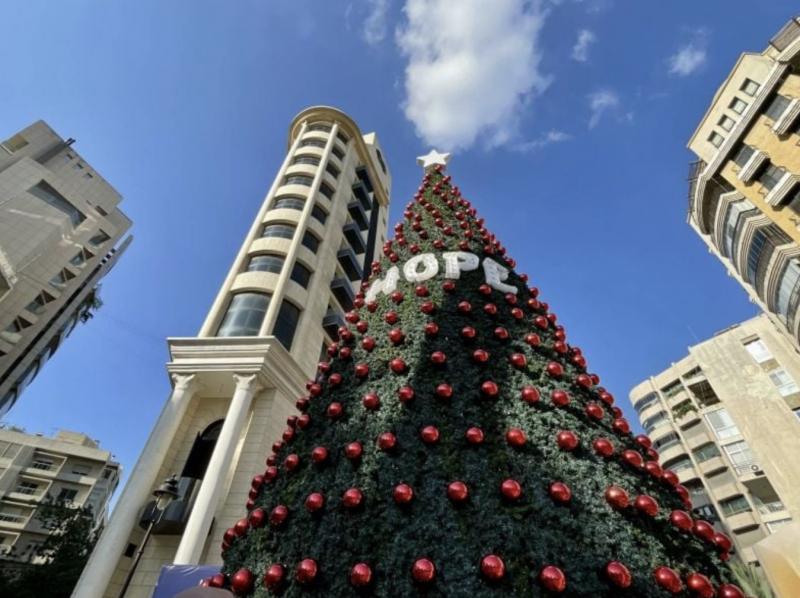
Sassine Square in Achrafieh, Beirut, decorated for Christmas and New Year's Eve. (Credit: Philippe Hage Boutros/L'Orient-Le Jour)
Lebanon’s aspirations for an economic recovery in 2023, the first in five years, have been shattered by the Israel-Hamas war, which extended into southern Lebanon. The southern border has witnessed continuous exchanges of fire between Hezbollah and the Israeli army, since the war broke out in Gaza on Oct. 7.
This somber assessment is the crux of the most recent World Bank (WB) report on the Lebanese economy, known as the Lebanon Economic Monitor (LEM).
Typically released between the October meetings of the WB and the International Monetary Fund (IMF), and December of the same year, the LEM paints a bleak picture of Lebanon’s economic prospects.
Jean-Christophe Carret, WB Director for the Middle East, said that limited progress toward a comprehensive resolution of the crisis has left Lebanon entangled in a socio-economic and financial downturn, intensified by the ongoing institutional and political stalemate.
He emphasized the recent positive impact of tourism on economic growth, but underscored that this alone cannot serve as a substitute for more resilient, sustainable and diversified growth drivers. Those are necessary to withstand shocks and steer the economy toward a robust recovery.
In its report, the WB also points out that the 2006 war in Lebanon — which saw the Israeli army temporarily invade the south of the country — resulted in loss of economic output amounting to 10.5 percent of GDP, and both direct and indirect damages totaling $3.1 billion.
Three scenarios
Prior to the outbreak of the Israel-Hamas war on Oct. 7, the WB anticipated that inflation in Lebanon would surpass 230 percent by the year’s end, with the public debt/GDP ratio projected to climb from 171.2 percent to 231.3 percent.
However, there was also an expectation of a modest rebound in Lebanese GDP by 0.2 percent in 2023, reaching $18.17 billion. This would mark a noteworthy development since the onset of the crisis that has plagued the country since the close of 2019, causing a threefold reduction in GDP.
Rather than presenting a single revised projection for Lebanese GDP in 2023 to gauge the impact of war, the WB has put forth three scenarios, based on the decline of “travel revenues,” and “tourism spending” by Lebanese expatriates in the fourth quarter:
• If spending decreases by 50 percent, the WB projects a contraction of 0.6 percent, resulting in a GDP of $17.85 billion.
• With a 7 percent reduction in spending, the WB anticipates a contraction of 0.7 percent, leading to a GDP of $17.72 billion.
• In the event of an 80 percent decrease in spending, the WB expects a contraction of 0.9 percent, yielding a GDP of $17.65 billion.
Social impact
Based on these findings, the WB fears that the social impact from the war shock on the Lebanese economy will be significant.
It references ‘preliminary data from a household survey conducted between 2022 and 2023, indicating that poverty continued to increase (prior to the war), and household living conditions persisted in their decline.
As per the survey, approximately three out of five households consider themselves to be poor or very poor.
The contraction of vital tourism-related sectors like hospitality and catering is anticipated as a significant social consequence. Additionally, the displacement of populations escaping southern Lebanon is expected to exert pressure on the overall quality of life, posing risks to education and healthcare access.
The WB report added that if the war persists or escalates, the challenges for Lebanon will intensify, given that the country is deemed ill-equipped to handle such repercussions.
The report cautions that an escalation of the conflict could inflict severe and enduring damage on Lebanon’s already fragile infrastructure, particularly in the electricity, water and transport sectors. It highlights the potential risks, including the possibility of a complete freeze in what remains of the financial system, a substantial decline in imports leading to shortages and the potential stagnation of the exchange rate.
This comes at a critical juncture when the Lebanese lira has already experienced a staggering 98 percent depreciation compared to its pre-crisis level.
For the moment, Lebanon has not been entirely abandoned by its diaspora, as evidenced by the national carrier, Middle East Airlines (MEA), which had to readjust over 150 flights during the holiday season. MEA had initially reduced its services by half in the weeks following the start of the war.
Additionally, the streets in the capital have experienced notable congestion in recent days, as is customary in the lead-up to Christmas and New Year’s Eve.
This article was originally published by L'Orient-Le Jour. Translated by Sahar Ghoussoub.